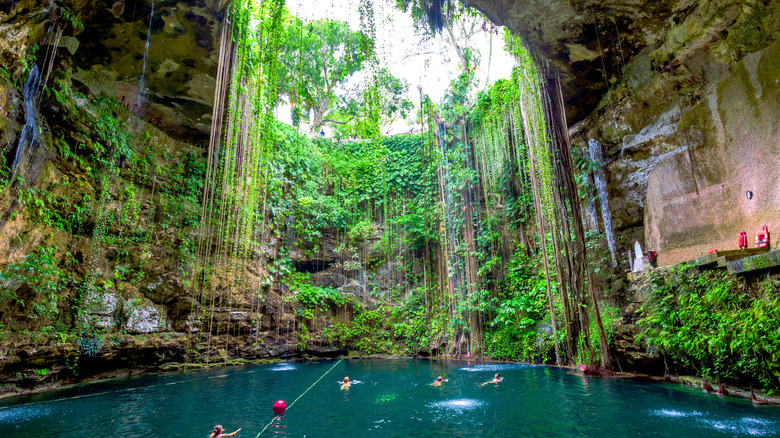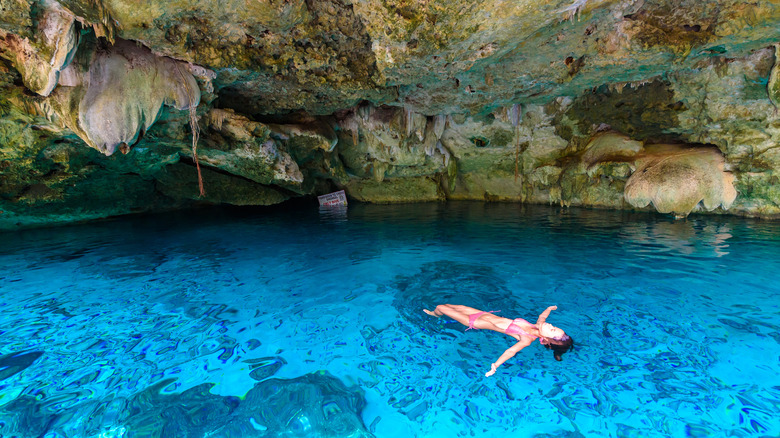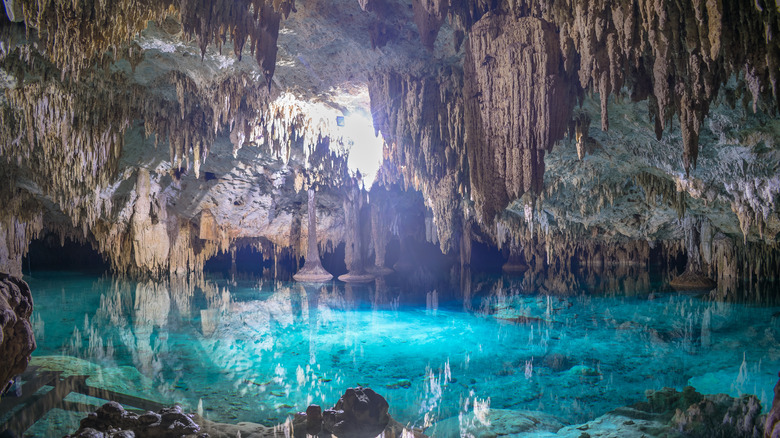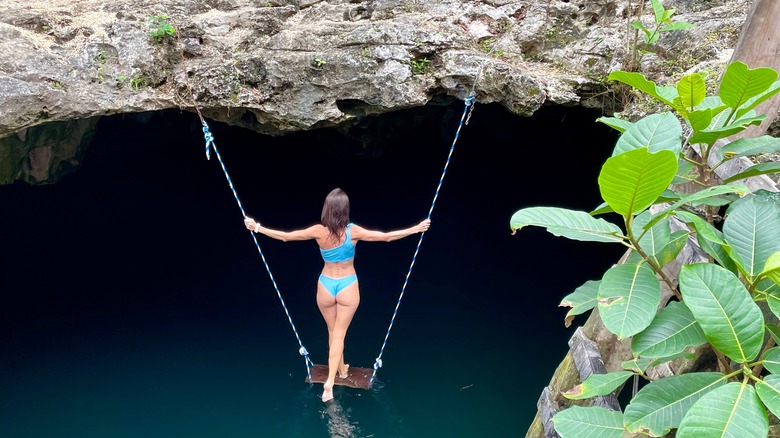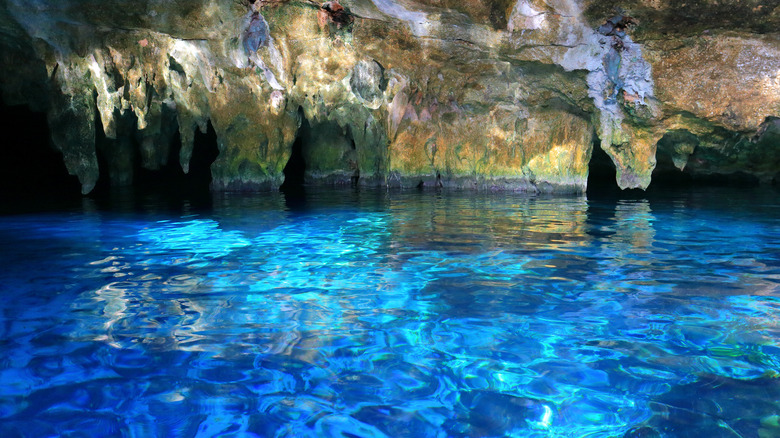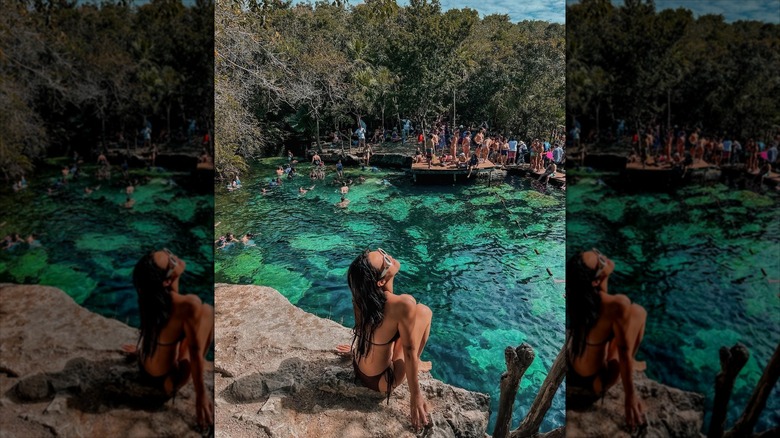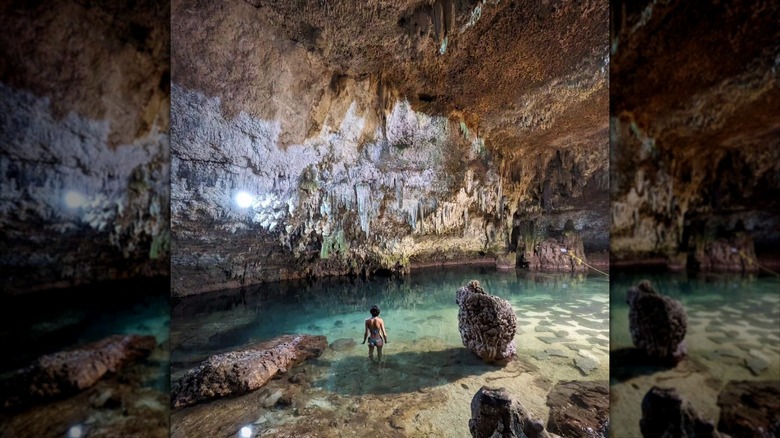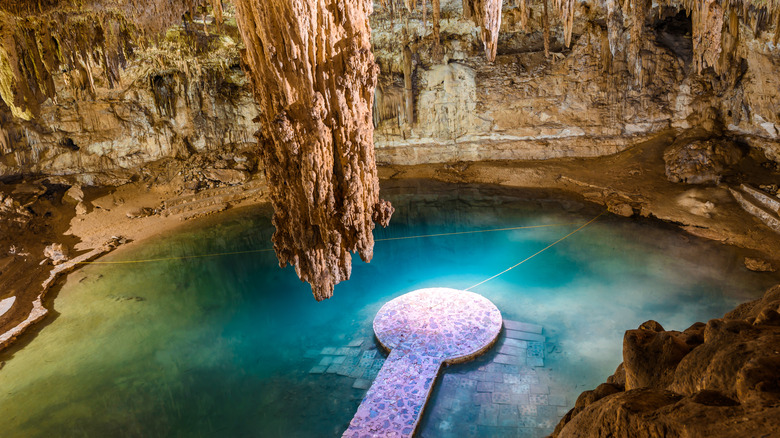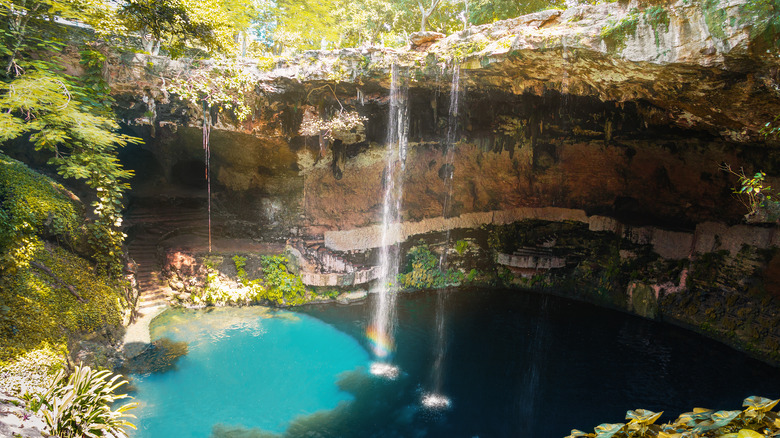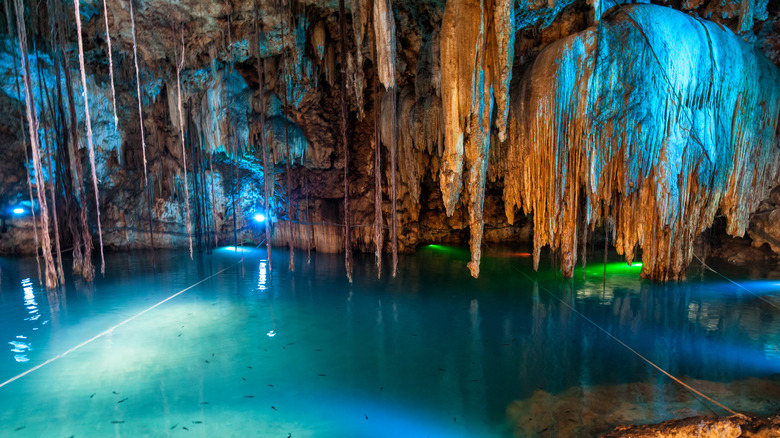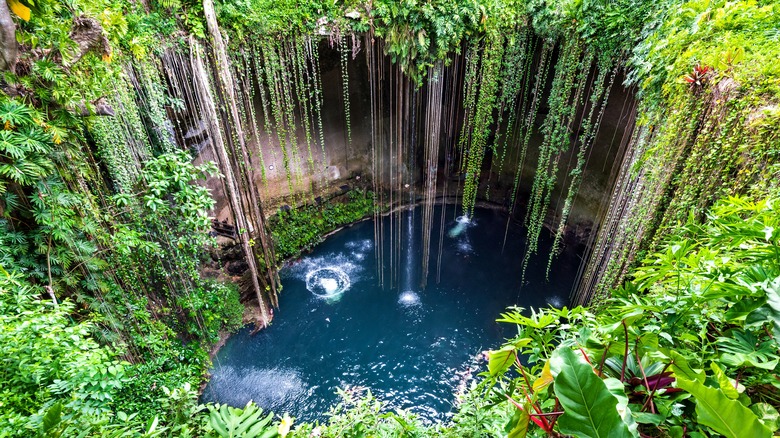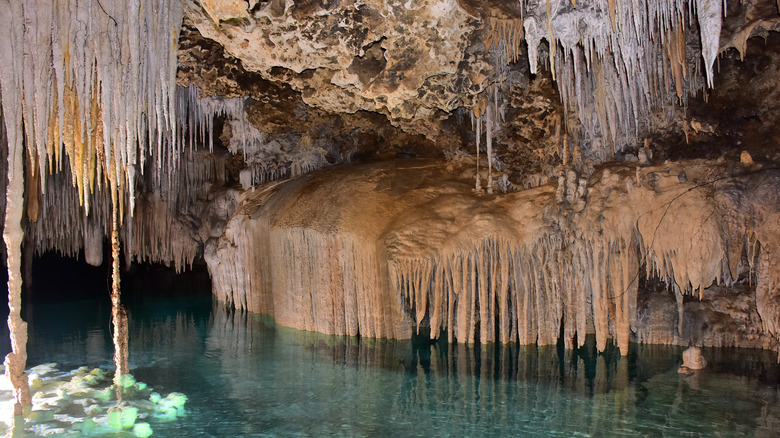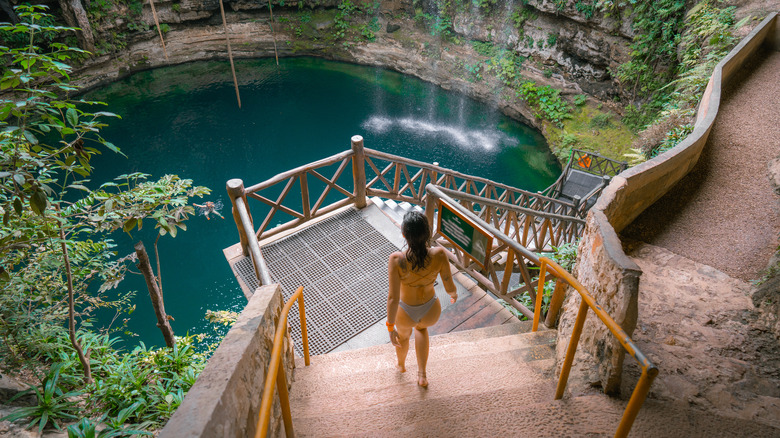The Most Breathtaking Natural Swimming Holes In Mexico, According To Travelers
The Mayans believed that cenotes, the deep freshwater sinkholes connected to an extensive underground river system, were also a connection to the gods, the place where they lived and listened. They called these holy spots "d'zonot," or "sacred wells," which the Spanish changed to "cenote." The sacred wells provided a nearly limitless source of fresh water, allowing cities like Chichén Itzá to blossom. To this day, the bottom of the cenotes are rich depositories of ancient pottery, jewelry, fossils, and sacred energy.
Today, the Yucatán Peninsula is home to over 7,000 cenotes, the largest concentration anywhere on the planet. Some are buried deep inside subterranean caves, where turquoise water laps against psychedelic stalactite and stalagmite formations. Others are partially covered, while others are fully exposed, allowing grateful visitors to bask under lush Caribbean jungles and dangling vines. All remain as sacred today as they were thousands of years ago.
We selected some of the most breathtaking examples of these sacred wells. We hope the list samples the best of all the different types of cenotes, from open-air turquoise lakes to otherworldly caves and everything in between. We start just north of Tulum, a beachy city hosting evocative Mayan ruins, and work our way clockwise around the peninsula to the charming old city of Valladolid and the famous Chichén Itzá, ending in a "secret river" near the sun-soaked Playa del Carmen. So grab your wetsuit, your headlamp, and your water shoes, and let's go swimming.
Cenote Dos Ojos
Cenote Dos Ojos has two eyes, and many divers flock to its gorgeous crystalline water surrounded by various fascinating rock formations. One of the region's most popular and photogenic cenotes is so-named for its "two eyes" — two pools connected by a walkable or swimmable near-200-foot tunnel. The cenote is regularly named one of the top diving destinations in the world due to its unusually clear, almost transparent water, which allows divers to comfortably enjoy scores of brightly colored fish and see up to 330 feet below them.
Translucent as it may be, the water is also up to 387 feet deep, inside a dark cave, and often affected by currents. Divers need to be certified and travel with a guide or tour group to get under the water. In some of the more shallow areas, less experienced swimmers and snorkelers can splash around and enjoy the refreshingly cool water (often about 75 degrees Fahrenheit) and the occasional fluttering of a bat over a fascinating stalactite formation. Life jackets are mandatory and available for rent at the entrance, alongside diving gear and flashlights.
Dos Ojos is conveniently located about a 30-minute drive from Tulum and about 45 minutes to an hour from Playa del Carmen. It's also a part of the larger Parque Dos Ojos, which includes seven other cenotes. Some of the nearby cenotes, like Nicte-Ha and Jaguar, are open-air, meaning they are not obscured by caves.
Cenote Sac Actun
Just a seven-minute drive away from Dos Ojos is Sac Actun, an underrated gem that's Mayan for "White Cave." In 2018, researchers discovered that Sac Actun is part of the same cave system as Dos Ojos, the Sistema Dos Ojos, which, at 215 miles, is the world's largest underwater cave system as of January 2023.
Since one could argue that Sac Actun is a bit like the "third eye" of the Dos Ojos, it offers a somewhat similar experience but with just a fraction of the crowds. Visitors rave about the invigorating, slightly eerie experience of snorkeling in shimmering turquoise waters in near total darkness, of ducking under limestone stalactite and watching tropical fish and bats at the same time.
While both cenotes boast bats and fish, only one has a dead mammoth, at least that we know of. A section of Sac Actun is known as Cenote Pet Cemetery due to the discovery of several incredible fossils. Book a guide to see the remains of the mammoth, as well as prehistoric pumas, jaguars, mammoths, and even a human female. Some archaeologists consider these remains the oldest evidence of human habitation in the Americas.
Cenote Calavera
You may have seen a photo of your favorite Instagram influencer dangling over turquoise water on an 8-foot rope swing hanging from a perfectly circular rock opening and wondered, "That looks awesome — but where on Earth are they??"
They're at Cenote Calavera, whose unusual optics make it one of the world's most photogenic spots. "Calavera" is Spanish for "skull," so named because the hard limestone rock over the water looks a bit like the bones of the cranium, and the three holes resemble eyes, nose, and mouth. This devilishly handsome face opens into the turquoise waters of the longest underground river in the world. Just 8 feet separate the skull from the water, and the enduring popularity of the site lies largely in the different ways to get there. Some take the wooden ladder, others scale down the rope swing, and many others, GoPros firmly attached to their foreheads, plunge or dive right in.
Once visitors have enjoyed the surrealist fill of swinging and swimming under the perfect circle over their heads, you can enjoy the lush tropical scenery from hammocks or benches. Beautiful as Calavera is, it is also called "The Temple of Doom" because archaeologists have found the remains of more than 100 bodies on the site. Before you panic, none of them were modern tourists who died jumping into the water — as always, exercise caution.
Gran Cenote
There are over 7,000 cenotes in the Yucatan Peninsula, but there's only one Gran Cenote. This semi-open expanse of caves, open pools, and grottos just 3 miles from Tulum town center truly earns its title as one of the most breathtaking cenotes in the region thanks to its convenient location and incredible array of spellbinding attractions.
Many cenotes are either located inside dark caves or under the blazing sun of the Maya Riviera. Gran Cenote is both. Outside, visitors can swim in crystal clear, bright turquoise water with a sandy floor, marveling at either the color of the water, the fish and turtles inside, or the limestone, dangling vines, and lush tropical vegetation surrounding it. Visit in January or February to spot the occasional toucan. Stroll along the wooden walkway that encircles the cenote through several possible entryways into the dark and mysterious cave, which splits into several smaller grottos. Unlike some of the more forbidding caves, Gran Cenote offers some areas to sit, relax, swim, and take photos of the incredible stalagmite and stalactite rock formations.
Visitors generally advise arriving around 8 a.m. to avoid crowds. There is a large parking lot, food stalls, lockers, and swimming equipment rentals.
Cenote Azul
The word "azul" may conjure up images of bright turquoise waters under brilliant cerulean skies, and that's exactly what you'll find at the aptly-named Cenote Azul, perhaps the most "Cancún" of any of the cenotes.
The large, open cenote is like a sparkling blue lake, full of small beaches, docks, limestone cliffs, and lush jungle vegetation. Visitors praise the cenote as a family-friendly spot boasting warm water, beautiful fish, and shallow waters. Toward the cliffs, the water is about 18 feet deep, making it perfect for jumping and diving from either the 10.5-foot dock or the limestone cliffs. Hikers will enjoy a beautiful trail that encircles the cenote.
The beachy atmosphere and accessible waters make this a popular choice, so visitors recommend mornings and weekdays for the fewest crowds. But with crowds come amenities: visitors will appreciate the big parking lot, snack bar, lockers, and equipment rental on offer. Just make sure to bring cash – credit or debit is not accepted. Anyone in the mood for more turquoise, open-air cenotes can enjoy nearby cenotes like Cristalino, Eden, and Chikin Ha. Visitors will also marvel at the nearby Sian Ka'an Biosphere Reserve, a UNESCO World Heritage site and the largest protected area in Caribbean Mexico that offers everything from ancient Mayan ruins to mangroves and monkeys to crocodiles, flamingos, and so much more.
Cenote Choo-Ha
Many of the open cenotes are crowded, while many of the cave cenotes can be intimidating and too often just as crowded. Cenote Choo-Ha is an under-the-radar, under-the-ground cenote near the Cobá Ruins that offers clear, shallow swimming amidst some of the most beautiful rock formations anywhere. Water drips from the rocks into the clear pools below, giving the cenote the name "Choo-Ha," or "water that drips."
Climb down a wooden staircase into a cave with unusually colorful, whimsical rock formations that almost look like something imagined by Salvador Dalí. These impressive formations can be enjoyed either from the wooden walkway that leads through the cave or by taking the stairs into the clear, shallow turquoise water. As the water is so shallow, lifejackets and guides are not required, unlike many other cenotes. While that makes Choo-Ha an excellent option for kids and inexperienced swimmers, it also makes diving impossible.
In the land of 7,000 cenotes, there is always more to be explored nearby. A single ticket will buy entry into Choo-Ha and its two sister cave cenotes, Tankach-Ha — which boasts waters that are even more brilliantly blue — and Multum-Ha, which is renowned for a brilliant skylight that lets an otherworldly stream of light in at various points during the day. All are located about a ten-minute drive from the Cobá Ruins, the site of an ancient Mayan city home to one of the tallest stone pyramids in the Yucatán.
Cenote Suytun
Instagram may be full of pretty people dangling from the top of Cenote Calavera, but it's just as full of people stretching out their hands under a Chihuly-like chandelier mega-stalactite, illuminated by a celestial shaft of light breaking through the small skylight. The long, rounded platform leading deep into the turquoise waters of Cenote Suytun has become the iconic image of cenotes, representing them the way the Eiffel Tower has come to represent Paris or the Golden Gate Bridge San Francisco. Unsurprisingly, there's often a bit of a line to make it to the end of the famed bulbous pier, but many say it's well worth it — in fact, the cenote was one of a few to receive the Tripadvisor Traveler's Choice designation. To avoid crowds, come in the mornings, around 9 a.m., or during closing time at 4:30 p.m. If the beam of light is most important, arrive mid-day. Make sure to bring water shoes since the pier is often at least partially submerged.
Anyone who likes to swim should bring a wetsuit, as the turquoise water is about 75 degrees Fahrenheit, 16 feet deep, and fabulous for swimming and snorkeling. The site also comes with showers, changing rooms, restrooms, lockers, and an on-site restaurant. Once you dry up and head back up the imposing stone staircase, don't miss nearby Valladolid, a charming, colonial city full of beautiful old cathedrals, plazas, and, naturally, another beautiful cenote.
Cenote Zaci
After soaking in the romantic pastel-colored galleries and cobblestone streets that make Valladolid one of Mexico's pueblos magicos, you'll be swooning and probably a little hot. This is the Caribbean, after all. To cool off, either grab some of the town's renowned ice cream or walk just 10 minutes to arrive at Cenote Zaci, a large cenote in the middle of the city that many say almost functions like a public swimming pool popular with locals.
This large, aquamarine lagoon is nestled under towering cliffs of limestone, into which several layers of walkways are carved. Long vines dangle gracefully into the water, and on weekends, so does an artificial waterfall. About half of Zaci is open, while the other half flows seamlessly into a shaded cave. Visitors note the water is unusually cold, but this often feels refreshing on hot days. The water is full of algae, which makes it murky, so it's not the best for snorkeling. But for cliff divers, it more than makes up for this. Zaci's water is up to 300 feet deep, and the cliffs above have numerous accessible spots from which to jump, some as high as 26 feet up. As always, be careful, as there are no lifeguards, and the waters below can be crowded.
Jump enough, and you'll work up an appetite. Climb to the top of the cliffs to enjoy an inexpensive, tasty restaurant with a high, thatched roof that offers Mexican classics.
Cenote Dzitnup
Head just 5 miles outside Valladolid for a nice bargain: two stunning cenotes for the price of one. Cenote Dzitnup, named after a small nearby village, is actually a complex of two cavernous cenotes, Samula and X'Keken, which are across the street from one another. X'Keken is named after the Mayan word for "pig," because local legend says it was discovered by a farmer searching for his pig. The pig happened upon something quite extraordinary: a deep canyon where red-tinged stalactite formations resembling an explosion of candle wax gently dip into the turquoise pool beneath them. The water isn't particularly deep, making it an excellent spot to bob around while enjoying the almost Martian landscape.
Across the street is Cenote Samula, which is most renowned for a skylight that brings in floods of celestial lights over a deep pool of turquoise. A tangle of majestic vines reaches all the way down to the water, which, at first glance, might be mistaken for a waterfall, especially when illuminated by the beams of light.
In the Yucatan, you never have to travel far to reach the new complex of cenotes. Near Dzitnup are the Saamal and Oxman cenotes, two delightful azure pools surrounded by a circle of rock and vine that eventually opens into a circle of sky and trees.
Cenote Ik Kil
No trip to the Yucatan is complete without a visit to Cenote Ik Kil, the lush, vine-strewn, open-air pool just a six-minute drive from Chichén Itzá. Yes, it's crowded, but like most touristy spots, the crowds are there for a reason. They're there to jump into the perfect circle of teal under a swirling expanse of towering limestone. They're there to swim under the curtain of verdant vines or the trickle of waterfalls as they marvel at the catfish and occasional turtles with whom they share this sacred bath, which the Mayans believed was home to the rain god Chaac.
"Truly magical," wrote one Tripadvisor reviewer. "All other visitors were glowing and smiling — the place has such a positive vibe." Many reviewers also glowed and smiled about the many spots to jump from about 15 feet into the 90-foot-deep water. In fact, the picturesque spot is so good for jumping that it was a stop on the international Red Bull Diving Competition three times.
As one of the most popular spots in the region, Ik Kil is equipped with every amenity, including lockers, changing rooms, bathrooms, an on-site bar and restaurant, and even on-site cottages for rent. Those cottages will be handy for anyone interested in touring nearby Chichén Itzá, the evocative ruins of one of the largest Mayan cities, one of Mexico's most visited attractions.
Cenote Río Secreto
After the crowds of a Red Bull competition site, many visitors might appreciate the dark, mysterious, evocative caves of the Secret River. In the Yucatán, pay attention to where your animals lead you. A pig supposedly helped a farmer discover Cenote X'keken, and as recently as 2004, local landowner Don Cleofás followed an iguana into the intricate semi-sunken cave system of the Río Secreto. Now, one of Mexico's newest cenotes is also one of its most unique.
Book a certified guide to embark on a half-day tour through 8 miles of dark, still semi-secret river that flows through the caves. Once you put on your headlamp, you'll marvel at some of the most fantastic stalactite and stalagmite formations anywhere in the Yucatán, if not the world. At one point, a mass of limestone almost looks like an entire whale skeleton is hovering over bright turquoise water. Embrace your inner Indiana Jones as a guide leads you through this gorgeous abyss. The Mayans considered Río Secreto one of the holiest sites in the world, and some tours incorporate elements of ancient Mayan shamanic practices to add to the mystery and majesty of this breathtaking secret.
Once back on land, the on-site open-air restaurant provides a full Yucatán buffet. And after so many hours in the dark, many visitors will appreciate that just 15 minutes away lies Playa del Carmen, a sun-soaked symphony of every hue of tropical blue.
Methodology
Whenever we thought we had provided the best, most diverse list possible, we learned that five equally incredible cenotes were located just steps away. To narrow 7,000 down to 11, we looked at different traveler reviews and blogs and paid attention to which cenotes were lauded in various sources. We also tried to create a list that encompasses something for everyone, whether you don't mind a crowded, touristy, open-air spot or prefer a secret, silent cave. We also tried to find places that offered sufficient amenities and a diverse range of recreational activities like swimming, snorkeling, scuba diving, or spelunking. We also looked at a variety of incredible images and videos of different cenotes and asked ourselves which one seemed the most sacred.
